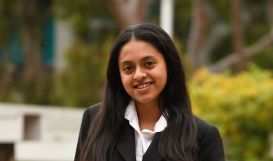If you could go back in time, what advice would you give to yourself before starting the expedition?
Having only recently moved to Australia from South Africa, the months leading up to the expedition had been filled with quite a lot of change and growth.
I told myself that I would take every opportunity as it came and not let my classic overthinking brain get in the way of trying new things – my overthinking did help with mental preparations, packing and ensuring I had the right gear and would be comfortable even in super muddy or raining conditions. This turned out to be the right decision!
If I could tell myself one thing, it would be not to stress about Saltwater Crocodiles or Gympie-Gympie plants as those were a big worry of mine leading up to the expedition.
With the Earthwatch Student Challenge done and dusted, what other plans or goals do you have lined up?
Recently, I gave a presentation about my experience with mangroves and salt marshes to my school's staff and the Environmental & Sustainability Committee. The aim of the presentation was to educate and motivate people to get involved with citizen science through future Earthwatch projects and apps like iNaturalist.
I also introduced them to Saltmarsh SAVER surveys, which anyone can complete by downloading the Epicollect5 app and adding the Saltmarsh SAVER project, which provides step-by-step instructions for completing the questionnaire. Once completed this is added to the publicly available saltmarsh database and assists researchers by adding more data from more sources.
I also introduced these to my family, whom I brought along to a recent mangrove community talk. In general, my plan is to keep raising awareness by talking about my experience and passing on some of the knowledge I gained over this life-changing experience.
I feel that many don't get involved not because they don't want to but because there seem to be barriers in place that make people feel like they can't be involved. I felt that until very recently, so my goal is to see if I can help people realise that that isn't the case and break down some of those perceived barriers. The more people who are involved and care, the bigger difference we can all make. We are not alone, and we can all contribute.






